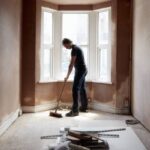Tariffs are hammering the home renovation industry, pushing designers, contractors and homeowners into a financial crunch as rising costs create chaos in the supply chain.
Chad Esslinger, an interior designer based outside Chicago, says the pressure has been building ever since President Donald Trump introduced sweeping global tariffs in early April.
Costs have been creeping up for Esslinger, telling CNN that one key supplier, providing lighting, rugs and furniture, slapped a 14% “temporary tariff surcharge” on Chinese imports and 2% on goods from any other countries starting May 12. Another vendor dealing in fabric and wallpaper also warned of imminent price hikes.
Don’t miss
- I’m 49 years old and have nothing saved for retirement — what should I do? Don’t panic. Here are 5 of the easiest ways you can catch up (and fast)
- Gain potential quarterly income through this $1B private real estate fund — even if you’re not a millionaire. Here’s how to get started with as little as $10
- Robert Kiyosaki warns of a ‘Greater Depression’ coming to the US — with millions of Americans going poor. But he says these 2 ‘easy-money’ assets will bring in ‘great wealth’. How to get in now
“I’ve seen it where sometimes they don’t even warn you,” he said. “I’ve gone to a website to look at a product I might have sourced a month ago, and now suddenly it’s a certain percentage more.”
To survive, Esslinger says the price hikes can’t be absorbed; they have to be passed on.
“Just like everything,” he said, “you have to pass that cost along if you want to stay profitable.”
‘The word that just keeps coming up is uncertainty’
The home renovation market has thrived in recent years, bolstered by an aging housing stock and fewer new builds. But that growth is being threatened by U.S. trade policy.
In 2024, China exported more than $438 billion worth of goods to the U.S., with nearly 19% of that total in machinery and appliances, including refrigerators, dishwashers, laundry machines, and another 4% in furniture and lighting, according to the U.S. International Trade Commission.
A recent agreement between the U.S. and China has temporarily lowered that rate to 30% for 90 days, but the broader market remains unsettled. Blanket 10% tariffs remain in effect for many other trading partners, and those rates could climb again after July 9.
“It’s top of mind at this point. On the contractor side, they’re waiting to see how it unfolds,” Julie Kheyfets, CEO of Block Renovation, a platform that connects homeowners with contractors, told CNN.
“The thing about renovations is, every renovation is different. You can’t stock a bunch of extra materials ahead of time, because every homeowner wants something different.”
That uncertainty has made it harder for businesses to plan and for customers to commit.
The U.S. home remodeling market is still expected to grow in the coming years, according to fresh projections from the National Association of Home Builders (NAHB).
The NAHB forecasts a 5% increase in residential remodeling activity for 2025, showing resilience in the face of economic and trade policy volatility. The growth, they say, is being driven by factors like aging housing, high home equity levels and an aging demographic.
But despite the projections, professionals like Esslinger say the lack of clarity is causing delays.
“The word that just keeps coming up is uncertainty,” he said. “I’ve had some clients say they’re going to hold off for a little bit and see how things go, while some have scaled back a little bit.”
Not everyone is seeing the same level of impact.
Nina Sepiashvily, who runs I&N Builders in New York City, says that while she’s noticed a slight uptick in costs, it’s nothing compared to the price surges triggered by post-pandemic inflation. Her focus is more on structural materials like lumber, rather than imported furnishings.
Tariffs on Canadian lumber, a key import for the U.S., sit at 14.5%, but the U.S. Department of Commerce has proposed more than doubling that rate to 34.5%.
“We haven’t really seen [tariffs] affect our costs yet,” Sepiashvily said, “Homeowners are uncertain about tariffs, they’re uncertain about their investments and they’re afraid to pull the trigger.”
But in New Mexico, interior decorator Sandy Schargel experienced the ripple effects firsthand when a lighting company canceled a large order due to tariff-related product discontinuations. Replacement options came with a 10% markup.
Schargel says the loss of access to more affordable imported items means she now often looks to American-made alternatives in a shift that may drive up costs for budget-conscious clients.
“When you come to the lower price points, American-made does limit things, somewhat,” she said. “Imported merchandise often has lower price options.”
She’s now telling her clients to buy early.
“I’ve told people to order what they need as soon as possible to avoid prices going up further down the line,” she said.
As for Esslinger, he hasn’t seen any price relief.
“No home goods importers I work with have said they plan to lower prices,” he said.
Read more: Want an extra $1,300,000 when you retire? Dave Ramsey says this 7-step plan ‘works every single time’ to kill debt, get rich in America — and that ‘anyone’ can do it
Tips for home renos during a tariff squeeze
If you’re planning a home renovation in 2025, you’re likely feeling the squeeze of rising material costs and ongoing tariff volatility. But, with the right strategy, you can still make your dream remodel a reality without blowing your budget.
Here are four ways to protect your wallet and stay on track:
1. Build a budget with wiggle room
Renovation costs can escalate quickly in today’s market. Experts recommend adding a 15% to 30% contingency to your budget to account for unexpected costs, like price hikes in materials. Use budgeting tools, whether spreadsheets or apps, to monitor every dollar spent and keep your project from spiralling out of control.
2. Source materials closer to home
Global supply chains remain unpredictable, and tariffs are making some imports pricier than ever. You can choose U.S. lumber or steel, which tend to be less tariff-sensitive. You can also work with local suppliers to cut down on shipping costs.
3. Explore financing options
Renovations are a big-ticket item, but there are smart ways to finance them, like home equity lines of credit (HELOCs), home equity loans, which offer fixed-rate options or personal loans, if you have strong credit and want to avoid tapping into home equity.
4. Get multiple, detailed bids
Don’t settle for the first contractor you meet. Make sure to get multiple bids and ask for itemized estimates to see exactly how much is being allocated to materials, labor and overhead. This can help you spot markups, negotiate better rates and make informed comparisons.
While the pause in the highest tariffs offers some relief, many in the home renovation business are preparing for continued volatility.
What to read next
- JPMorgan sees gold soaring to $6,000/ounce — use this 1 simple IRA trick to lock in those potential shiny gains (before it’s too late)
- This is how American car dealers use the ‘4-square method’ to make big profits off you — and how you can ensure you pay a fair price for all your vehicle costs
- Here are 5 ‘must have’ items that Americans (almost) always overpay for — and very quickly regret. How many are hurting you?
Like what you read? Join 200,000+ readers and get the best of Moneywise straight to your inbox every week. Subscribe for free.
This article provides information only and should not be construed as advice. It is provided without warranty of any kind.

